[BL602] BL602 PTBLU-W WiFi Module Pinout and Specs in EARU EAKCB-EWE-M Circuit Breaker
Here's details and pinouts for the EARU model EAKCB-EWE-M circuit breaker, purchased from AliExpress in Jun 2025:
https://www.aliexpress.com/item/1005006189189642.html

There's 6 rivets holding the case; you can just drill them out and then the case opens easily. The circuit breaker is rated up to 63A; the relay is marked at 60A maximum.
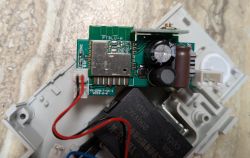
The rest of the construction looks very solid and easily capable of handling 60 amps.

Apparently these devices previously used a PSF-B wifi module. This one has a wifi module PTBLU-W based on the BL602. The module is mounted on a circuit board labelled YK-DPN-T-V1-1 which is dated 2023-6-6. I could not find any specs on the internet for the wifi module.
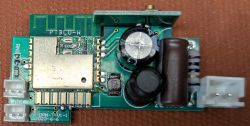
The power supply has no transformer, so the module should never be powered by mains voltage while testing and measuring signals and voltages on the circuit board.
The EAKCB-EWE-M provides a BL0942 chip for energy monitoring. Here's pictures of the other chips on the back side of the main circuit board. You can read the markings for just about every chip in one photo or the other.
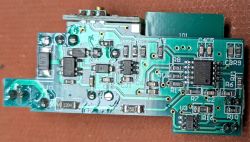
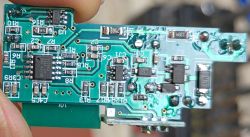
To inspect the PTBLU-W wifi module, you can bend one corner of the metal shield, but the only thing to see is the BL602 chip marking (but barely visible). To do more investigation, it is necessary to remove the metal shield. If you don't have a hot air gun, you can (permanently) remove the metal shielding with a pair of pliers.
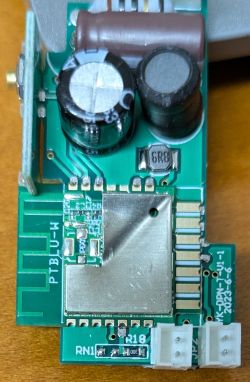
With some work, it was possible to trace the connection for every GPIO pin for the BL602. The photo below shows the GPIOs for the 21 pins of the wifi module. There seem to be 3 extra module pins. I don't have a hot-air tool to remove the wifi module so I wasn't able to inspect or test the backside of the module.
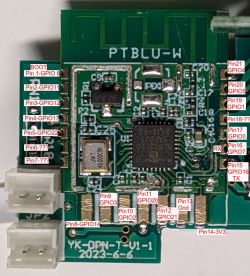
The main circuit board only uses 10 of the wifi module pins 5, 11, 12, 13, 14, 15, 16, 19, 20, 21. These are enough to control all the functions of the EAKCB-EWE-M, plus one extra pin that I don't know the function (pin 5 - GPIO 22). The wifi pin mapping is:
Pin 14 = 3V3
Pin 13 = Gnd
Pin 19 = Red LED, relay On/Off (active low) = GPIO 1
Pin 20 = Blue LED, wifi status (active low) = GPIO 5
Pin 21 = Push button switch (On/Off, active low ) = GPIO 4
Pin 11, 12 = Bi-stable relay control = GPIO 20 (Set pulse) and GPIO 21 (Reset pulse)
Pin 15, 16 = UART TX/RX connecting to BL0942 energy monitoring (GPIO 16, GPIO 7)
Pin 5 = ??? 200K ohm resistor to 3V3 ??? (GPIO 22)
There's an forum posting on how to configure the bi-stable relay in OpenBK; you may have to search further to get all the details for using BridgeFWD and BridgeREV.
https://github.com/openshwprojects/OpenBK7231T_App/issues/667
Note that you need to browse to 192.168.169.1 to access the starting OpenBK web page when the BL602 is in AP mode (with other chips, the starting web page is 192.168.4.1).
There's another posting about issues with OpenBK releases >=1.18.95 for the BL602 when activating the UART too soon after booting; a 10 second delay is recommended in the posting. https://www.elektroda.com/rtvforum/topic4127126.html
Please add to that last posting if you find other devices using the PTBLU-W wifi module, or find a simpler solution to activating the UART on a BL602.
MANY THANKS to everyone for their super-quick replies and support for this newbie!
https://www.aliexpress.com/item/1005006189189642.html

There's 6 rivets holding the case; you can just drill them out and then the case opens easily. The circuit breaker is rated up to 63A; the relay is marked at 60A maximum.

The rest of the construction looks very solid and easily capable of handling 60 amps.

Apparently these devices previously used a PSF-B wifi module. This one has a wifi module PTBLU-W based on the BL602. The module is mounted on a circuit board labelled YK-DPN-T-V1-1 which is dated 2023-6-6. I could not find any specs on the internet for the wifi module.

The power supply has no transformer, so the module should never be powered by mains voltage while testing and measuring signals and voltages on the circuit board.
The EAKCB-EWE-M provides a BL0942 chip for energy monitoring. Here's pictures of the other chips on the back side of the main circuit board. You can read the markings for just about every chip in one photo or the other.


To inspect the PTBLU-W wifi module, you can bend one corner of the metal shield, but the only thing to see is the BL602 chip marking (but barely visible). To do more investigation, it is necessary to remove the metal shield. If you don't have a hot air gun, you can (permanently) remove the metal shielding with a pair of pliers.

With some work, it was possible to trace the connection for every GPIO pin for the BL602. The photo below shows the GPIOs for the 21 pins of the wifi module. There seem to be 3 extra module pins. I don't have a hot-air tool to remove the wifi module so I wasn't able to inspect or test the backside of the module.

The main circuit board only uses 10 of the wifi module pins 5, 11, 12, 13, 14, 15, 16, 19, 20, 21. These are enough to control all the functions of the EAKCB-EWE-M, plus one extra pin that I don't know the function (pin 5 - GPIO 22). The wifi pin mapping is:
Pin 14 = 3V3
Pin 13 = Gnd
Pin 19 = Red LED, relay On/Off (active low) = GPIO 1
Pin 20 = Blue LED, wifi status (active low) = GPIO 5
Pin 21 = Push button switch (On/Off, active low ) = GPIO 4
Pin 11, 12 = Bi-stable relay control = GPIO 20 (Set pulse) and GPIO 21 (Reset pulse)
Pin 15, 16 = UART TX/RX connecting to BL0942 energy monitoring (GPIO 16, GPIO 7)
Pin 5 = ??? 200K ohm resistor to 3V3 ??? (GPIO 22)
There's an forum posting on how to configure the bi-stable relay in OpenBK; you may have to search further to get all the details for using BridgeFWD and BridgeREV.
https://github.com/openshwprojects/OpenBK7231T_App/issues/667
Note that you need to browse to 192.168.169.1 to access the starting OpenBK web page when the BL602 is in AP mode (with other chips, the starting web page is 192.168.4.1).
There's another posting about issues with OpenBK releases >=1.18.95 for the BL602 when activating the UART too soon after booting; a 10 second delay is recommended in the posting. https://www.elektroda.com/rtvforum/topic4127126.html
Please add to that last posting if you find other devices using the PTBLU-W wifi module, or find a simpler solution to activating the UART on a BL602.
MANY THANKS to everyone for their super-quick replies and support for this newbie!



Comments
What in this module acts as a current measurement? [Read more]
This information is already included in the description - BL0942 connected via UART. Classic. I have also seen it connected via SPI to the CBU a few times, but much less often. In addition to the BL0942,... [Read more]
@profanderson can you also post template as full JSON text from the Web App? [Read more]
Below is the template I'm currently using. Please note that I've decided to use the scripting method to toggle the bi-stable relay rather than use BridgeFWD + BridgeREV pin roles. P.S. The LED for power... [Read more]
This script will work, but I suggest you to move to channels. Declare dummy channels, like channel 2 and 3, and use setChannel 2 1 or 0, etc. This is because setting pin role will save it to flash,... [Read more]
Ahh yes! That's an excellent tip. :-) I'll rewrite the script today or tomorrow and post it here. [Read more]
. I have defined the question a bit badly. Does the 63A go through a measurement resistor? A current transformer? That's a bit more than the 16A found in sockets that measure energy consumption. [Read more]
The 63A goes through a current transformer. Also, other parts in the current path are very solid and heavy. I think there should be no problem carrying 40A without any heating. Going to 50A or 63A might... [Read more]
In the picture I see two two-pin connectors, probably one is from the relay and the other is from the current transformer. [Read more]
I've added another picture in the original description (just after "The rest of the construction looks very solid and easily capable of handling 60 amps.") It shows two 2-pin connectors on the left side,... [Read more]
@profanderson is this still the correct template? re https://github.com/OpenBekenIOT/webapp/pull/220 [Read more]